A Paipo
Interview with John Ruffels
October 24, 2010 (revised March 6, 2011) - Newcastle, Australia
Telephone interview by Bob Green
Introduction. John Ruffels
lived at Bondi for 40 years and has described the
surfoplane as "part of the landscape." The surfoplane was not only the
forerunner of the modern surfmat but a surfcraft that many surfers
first learnt the basics on. John was a postman for 37 years and in his
travels met a woman who had been a contortionist at the Tivoli. She
told John that her husband, Aubrey Ping, had played a role in the
development of the surfoplane. Examination of patent documents and
communication with the Smithers family did not confirm the role of Aubrey
Ping in the development of the surfoplane. However, Aubrey Ping did
know Ernest Smithers and was an interesting figure in his own right.
[See Note 1.]
In a U.S. patent
filed in 1934, the surfoplane
was described by Smithers as "an improved type of pneumatic surf board
or float." Smithers designed a craft which balanced speed and control --
two essential qualities of any surf craft. Prior to the surfoplane
there were a variety of lifesaving and recreational craft made of
rubber, or that were inflatable. Smithers's particular achievement was
that through experimenting with various design features such as length;
width; number, length, and size of internal partitions; friction grip;
and stiffness he developed a surf craft that was relatively easy to
ride, safe and fun. Smithers also played a significant role in the
marketing of the surfoplane.
Of Dr.Ernest
Smithers, John Ruffels has said: "Geez,
a story which involves Charles Kingsford Smith, Frank Beaurepaire, Phar
Lap, Bondi, Stan McDonald, Black Sunday, Sue and Joy Smithers AND the
inventor of both the Jaffle Iron AND the Surfoplane.....!! This bloke is
a legend!" The story of the surfoplane is also a story of an inventive
mind.
John
Ruffels and the Smithers family.
|
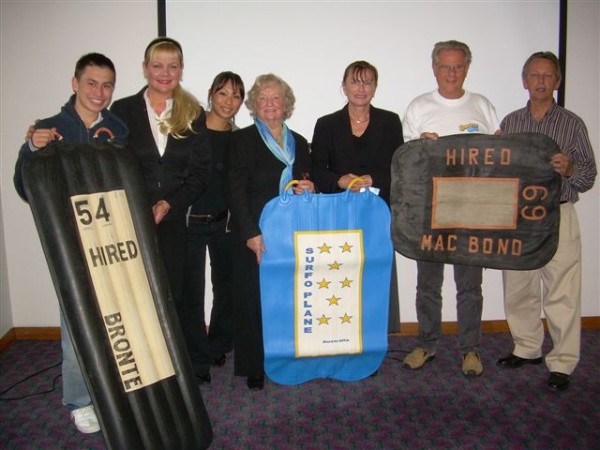 |
JohnRuffels
is on the far right with members of the Smithers family. Left
Hand Surfo was courtesy of Neil MacDonald grandson of Stan; the longer
Surfo was hired out at Bronte by Stan or Basil, via a sub-contractor.
Probably early 1950s. Centre Surfo is 2000 revival model. Right Hand
Surfo is Neil MacDonald's from the 1930's. Was rectangular but not big.
No handles, four barrels.
Photo
courtesy of the Smithers family. |
Questions & Answers
1.
Can you give some background into Ernest Smithers and some of his
achievements?
He started off as a
court reporter. He was
quite proficient when he first left to school but something got into
his bonnet and he decided he'd go back to school. Go to university, he
went to night school first, then university to get a medical degree. He
was going along swimmingly until he got into a serious disagreement
with the head of the medical faculty of the University of Sydney. So he
thought, "My chances of passing a degree at this university aren't very
good." So he upped with his wife and daughter and went over to Scotland
and England, and finished his degree there and came back. When he was
here, he needed money so he went over to Palm Beach and started
repairing yachts, and buying and selling yachts, to get a bit of money.
Medical student
E.E. Smithers, ca. 1925, when he was
studying at Royal Prince Alfred Hospital for his medical degree. His
studies were completed at Glasgow, in 1931.
|
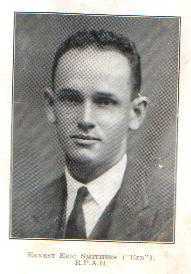
|
|
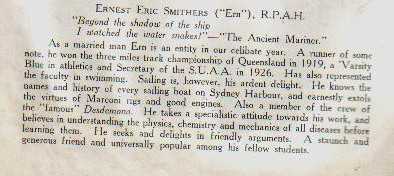
|
From
the Sydney University Medical Faculty Year Book. Smithers family
scrapbook.
2. Where did the idea of the
surfoplane come from?
What happened when he
was repairing these
boats is that he would use inflatable cushions on the boat to get ashore. I
had also heard that he was out riding either a rubber or wood
surfboard at Bondi and it broke in half. He had to use the other half
to come in. He realised that it was much more manageable in that size.
[See Note 2.]
Johny
Weismuller with rubber board and Tom Blake, ca. 1932
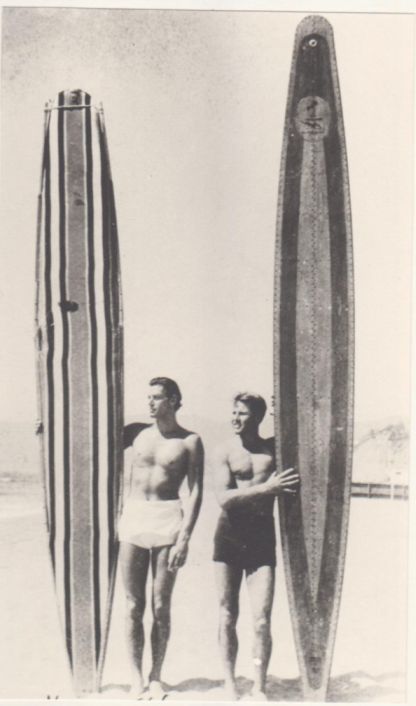
Photo
courtesy John Elwell and Gary Lynch.
So he spent eight years
cutting up rubber,
borrowing dis-used car inner-tubes from garages around Bondi, and
experimenting with lots of different rubbers and in the end, with
colours and he found that yellow was the best colour to see a
surfoplane from a distance and for safety purposes.
Smithers
surfoplane and excerpt from U.S. patent filed in 1934.
|
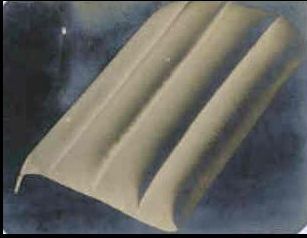
|
|
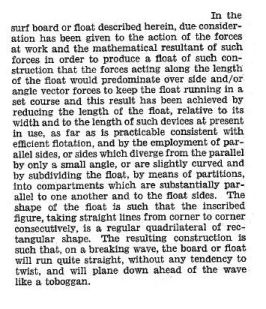
|
Source:
Application for registration of a
design by Ernest Eric Smithers and Carl Dodson Richardson for A surf
plane - Class 3. 9929. Dated October 7,1932. Len Smithers has reported
surfoplanes always had four panels, though his father designed a longer
version (about 18 inches longer) but there were very few of them. He
kept the bigger model for himself [see: Smithers Ernest E, et al. (1936, December 15; filed February 19, 1934). Pneumatic surfboard or float. U.S.Patent No. 2,064,128. Washington, D.C.: U.S. Patent and Trademark Office. Retrieved from www.freepatentsonline.com].The U.S. patent used the word
"speed" whereas the Australian patent used the word "mobility." The
Australian patent also includes an amendment dated January 23, 1936, deleting
the above words "or sides which diverge from the parallel by only a
small angle, or are slightly curved."
3. Any idea as to what his
motivation to make one?
He had an inventive
personality or bent. In
fact, over the years he invented an early car fridge; a contraceptive
gel which was used by women in the 1940s, but unfortunately the
impatience of the parties in the sex act would mean that it wasn't as
successful as it could have been; he invented the Tru Slice Bread Knife
which was a gun-metal rail which was about the thickness of a slice of
bread that was attached to the blade of a bread knife and this meant
that bachelors and incapable people could cut the perfect slice of
bread and not waste bread. And, what makes him a legend in my eyes, his
family claim that he invented the jaffle iron. Now there are toasting
irons that have been around in America since 1925, and a guy called
Champion over there claims to have invented that. But this one was the
Australian one, two round dishes with the two branding iron handles and
wooden ends that meant you could hold the hot metal.
Dr. Smithers also
patented a toaster in
1949, most likely a Jaffle Iron, not to be confused with the toaster he
also invented, which had a timing device in it. In later years he
retired to Sussex Inlet and they ran a motel there. His poor wife had
to get up and make breakfast for everyone. This answers your question
about the inventive mind. And his wife said, "I need to make five bits
of toast at once but they pop up at different time and I can't butter
five pieces of toast at the same time." So he took the timer out of the
washing machine, attached it to the five toasters and she could make
five pieces of toast at once. That's the kind of guy he was.
4. What were his family's
recollections of Ernest Smithers making and developing the surfoplane?
First of all, the
house was ankle deep in
lots of different coloured rubber, up and down the hallway of the
cottage that he lived in with his wife and children. That was the
recollection of family, that for years, over an eight year period up
until 1932, when he patented it.
5. You have mentioned that the
surfoplane was used in the Black Sunday rescue? [See
Note 3.]
That's right. What
happened, it was the job
of his good friend Stan MacDonald who ran the concession for the
surfoplanes, deckchairs and everything
at Bondi, eventually spraying mutton bird oil to give people good
tans. [See Note 4.] He ended up
being a partner with Dr. Smithers in another design of the
surfoplane called the Beacher, which I think was patented in 1933. The
original surfoplane was in 1932.
Stan MacDonald ca.
1920s and a surfoplane beach hire concession
|
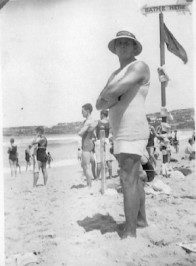
|
|
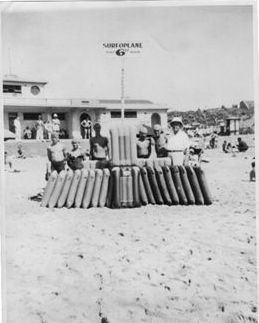
|
Photo
courtesy of the Local Studies collection, Waverley Library; photo
courtesy Alison Lee.
They used to collect these surfoplanes when people abandoned them after
the time was up because they couldn't be bothered coming back with them
and other people would rush off and ride them for nothing. They had to
scoop them up and carry about 10 or 15 surfoplanes on their head at
once. Stan was the father and Basil was the son. Basil would be coming
back with all these surfoplanes of his head, apparently he heard the
alarm from the lifesaving bell or whatever it was. People were getting
washed out. His father said, "Quick, get out the back there with those
surfoplanes and hand them out to the non-swimmers." Len Smithers
recalls being involved in the rescue and that six people could hang off
one surfoplane and it saved a few lives.
Max
Lambert from Clovelly Surf Life Saving Club in the lead at a Manly
carnival in the 1930s.
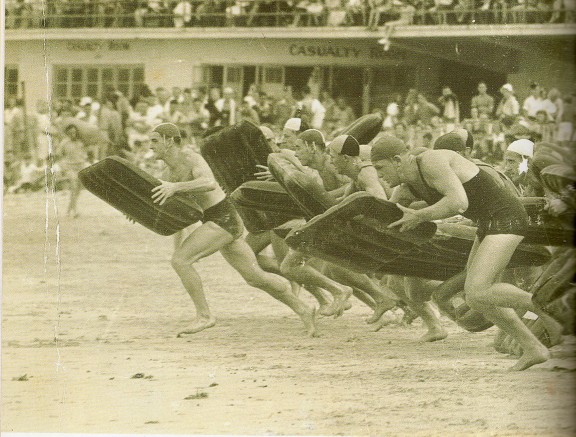
Source:
Clovellly SLSC photograph excerpt from: Cadigan, N. (2008). Evolution
of an icon: 100 years of surf life saving in NSW.
Sydney: University of New South Wales Press, pp. 130-131. See Note 5 for photo information and
use of the surfoplane by lifesavers.
What year was that?
1938.
6. What roles did Kingsford
Smith and Frank Beaurepaire play in the development of the surfoplane?
The only thing that I
can think of for Frank
Beaurepaire, who owned Advanx Rubber, is that he was associated with
rubber products like tires and possibly later on, the surfoplane. As
far as I know Kingsford Smith was
part of the syndicate that got the surfoplane going, The Surfoplane
Limited Company, and had their company on O'Connell Street, in the city.
And he also went around to Manly Council, Waverly Council and Randwick
Council to lobby them to allow them Stan McDonald and Ernest Smithers
to have the concessions to hire out surfoplanes on the beaches. [See Note 6.]
Surfoplane
company annoucement, ca. 1934, and a Surfoplane advertisement, ca. 1933
|
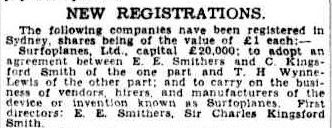
|
|
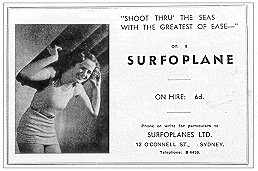
|
Company
News. (1934, April 11). The Sydney Morning Herald (NSW : 1842-1954), p.
15. Retrieved March 31, 2011, from
http://nla.gov.au/nla.news-article17072364. Advertisement from: Thoms, Albie.
(2000). Surfmovies: the history of the surf film in Australia.
Noosa Heads, Qld: Shore Thing.
7. You mentioned a syndicate -
who else was involved with the syndicate?
I don't know, I
haven't been able to find
that out. All I have been able to find out, as you have, is that there
are two patents in the patents office. One is an application for
letters patent for an invention by Surfoplanes Limited in 1933 (no
names involved) and the other one was an application for registration
of a design by E.E. Smithers Propriety Limited for a toaster in 1949
and
another item for the surfoplane in 1932. [See Note 7.]
Surfoplanes
Limited letterhead
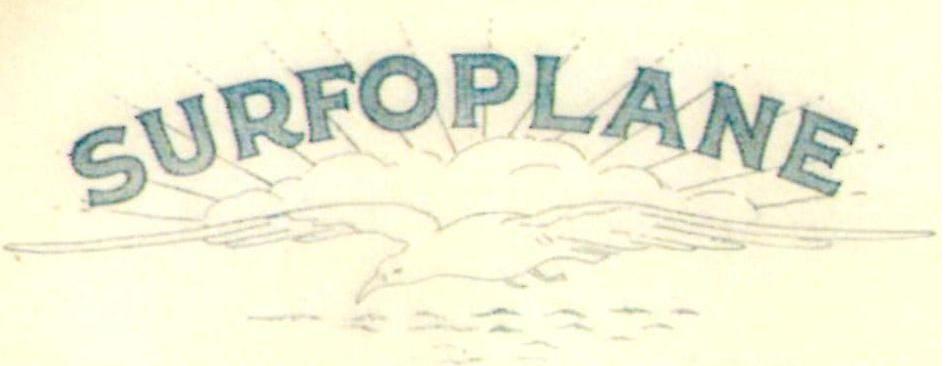
National
Archives of Australia.
I've sent you an
e-mail with a copy of a
letter from the Prime Ministers Office (Robert Menzies) in the National
Archives, with the names J.T Jennings (an M.P) on it.
He did have a lot
of
influential people
lobbying all sorts of people. They got a lot of publicity from the
papers because, whenever the beach season started, this new product was
very, very popular. They sold them in England, in America, New Zealand,
South Africa, in Newquay in Britain. They were very popular in lots of
magazines and newspapers loved to do stories on surfoplanes and how
kids loved the freedom of being able to swim with safety on them. But I
don't know who else was involved.
One thing that is interesting, in the 1932 patent another man is
involved in the patent. His name is Carl Richardson. This bloke I've
never even heard of before and his name is on the patent. So that's a
bit mysterious.
8. Smithers sold the design
didn't he?
A couple of
complicated things happened. In
November 1936, he took Advanx Rubber to court because they were actually
making surfoplanes while the company had the patent. When he was in the
court, one of the lawyers said to him, "You're silly paying all that
money for the lawyers. You should sell the company to all these big
business people and free yourself of the headaches." So he did that and
him and Stan MacDonald went off and redesigned the surfoplane and
called it the "Beacher." Apparently it had improvements relating to a
pneumatic surfboard or float. And that's what their application said.
Post-1930s
surfoplanes. The original model didn't have handles.
|
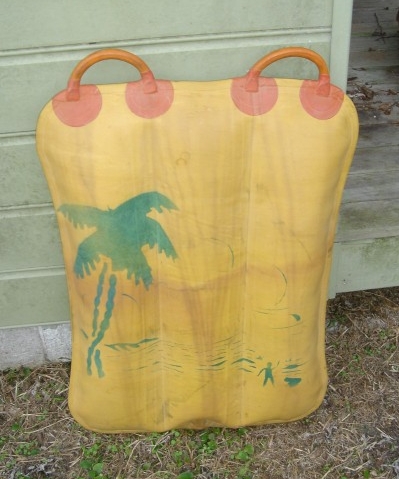
|
|
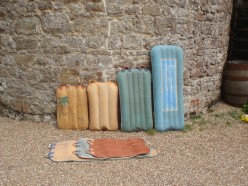
|
Photos
courtesy Henry Marfleet.
Can you tell me
about how the Beacher differed?
That's the tricky
question. I
don't know. I'm
not sure when handles came in. I have the impression they came in the
early 1950s. If you look at all the photos in the New South Wales State
Library, of surfoplanes, the lot of them don't have handles until after
the war. A short canvas mat on the rubber raft, on the inflatable
surfboard, that was so that you could get a grip with your body lying
on the top of it, was the substitute before handles were there.
9. What do you think has been
the contribution of the surfoplane to surfing?
In my opinion it gave
lots of young people an
opportunity to get out in the water and work out manoeuvrability, and
to work out the rhythm of waves and to understand nature's power and to
have a bit of respect for it; and to get ducked a few times and get the
confidence, and then eventually to slowly stand up. And then when they
got too big for that because there were no fins on surfoplanes in the
old days, they did have some later, they would then develop the
confidence to move onto surfboards. That and the fact that a lot of
people who were not very good swimmers but didn't mind going in the
water went out on surfoplanes and felt a bit more confident in the
water. Confidence and understanding of water flow would have been the
main things I took from surfoplanes. [See Note 8.]
Surfoplanes
were popular with all ages. New Zealand and Bondi.
|
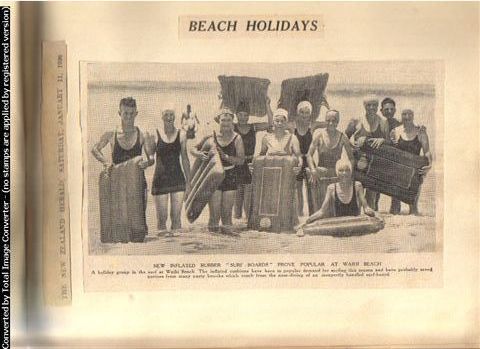
|
|
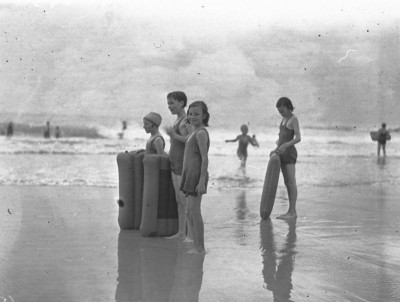
|
Source: Photographer unknown. (1936, January 11). Beach Holidays.
[Image of photograph]. Auckland, New Zealand; New Zealand Herald. Photograph provided by Allison Lee. And, Sam Hood
Collection. Mitchell Library, State
Library of NSW # hood_01543.
I believe a lot of people who became good surfers
started off on surfoplanes.
You often see
in biographies or
in newspaper articles, like Tom Carroll or Mark Richards, probably
George Greenough, too.
Mark Richards
at Kirra ca. 1960, and with surfoplane.
|
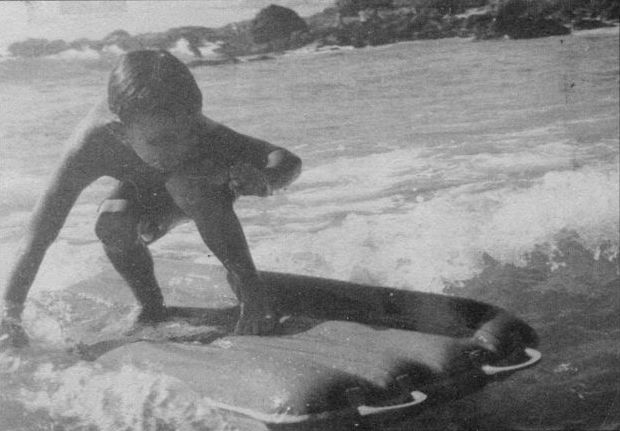
|
|
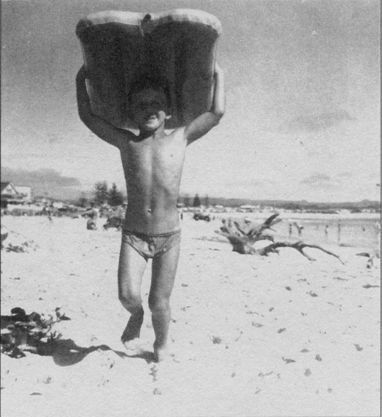
|
Photo
courtesy of Mark Richards. From: Knox, D (1992). Mark Richards : A
Surfing Legend. Sydney. Collins Angus & Robertson.
George Greenough still rides surf mats.
I heard that.
Actually there's
a wonderful
anecdote I picked up when I was doing a story about a superior
club down at Bondi started by the Sydney golf club (which was pretty elite).
They had their own bathing club called the Rose Bay Surf Club. There
was a 90 year old lady there I think, back in the 1970s or 1980s, who still
used to go down to the beach in Summer with a surfoplane. So that was
pretty good.
George Greenough on a modern
surf mat, a 4th Gear Flyer prototype, which eventually became
known as the "4GF Standard" -- C Street, Ventura, California, ca. 1985.

Photo
courtesy of: Paul Gross.
10. Is there any other aspects
of your research on Smithers that you wanted to add?
I'd just like to say, that when
somebody
invents something there is often a lot of people are thinking along parallel
lines or they see their invention and think of something which could
improve that. (For further elaboration on these thoughts and other possible precursors to the surfoplane, including comments
by Len Smithers, see Note 9.)
| Drawing from Smithers 1934 U.S. patent and a
1924 U.S Pneumatic surfboard |
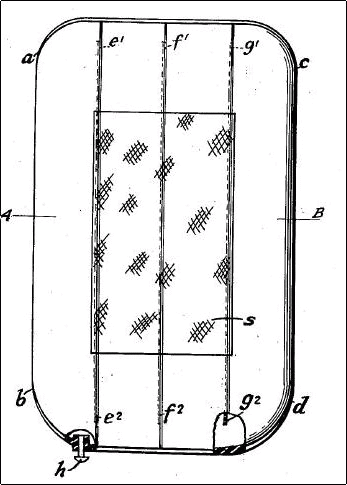 |
|
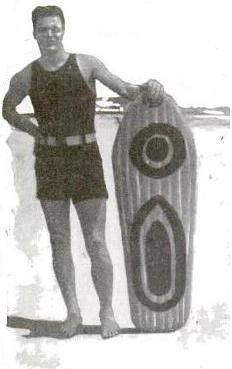 |
Photo:
Smithers's U.S. patent 2,064,128. For the photo on the right, 1924 pneumatic surfboard,
see: Unknown. (1924, September).
Pneumatic Boards for Surf Riders Are Safe and Easily Carried. Popular Mechanics, 42(3), 362. Retrieved from Google
books.
Do you think he
surfed them much himself?
Yes, I think
he did (see Note 10).
He certainly had a love of water when he went down to the Sussex Inlet.
I didn't tell you the end of the story about the washing machine. He'd
taken the timer out of the washing machine and his wife now had five
toasters that popped up at once, so she was happy with the buttering.
But the washing machine never, ever went again. So that's really a
parable about inventors and how they think. Most of his inventions,
like the car fridge which he made out of some materials that the
Americans had devised for insulating, it was a wax, that they insulated
packets of cargo that they dropped out of aeroplanes to people in
tropical islands and things. It had that insulation facility. He
realised that if they lined a metal box with bamboo and put this wax in
the middle of it, he could insulate it so then people could have a
fridge that they could put in their car.
Ernest
Smithers with surfoplane
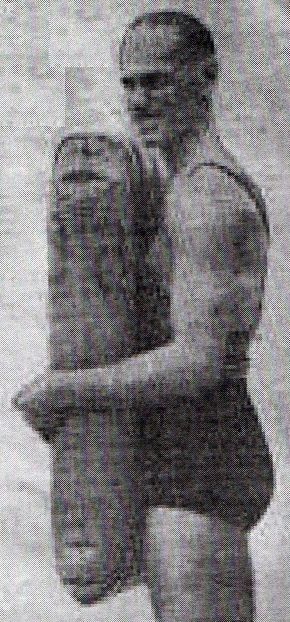
Photo: Williams, J. (1934, January 6). Riding on Air in the Surf. The Telegraph. Sydney, Australia.
|
Note 1. Deian
Ping advised, "I do not have an exact
birth date, but he would have been born around 1898 - 1899. He was an
exceptional student who won a coveted "State Scholarship" to Nudgee
College where he gained subject prizes, the Dux and full colours in
Rugby and Rowing. He won his scholarship to the University of
Queensland, in 1916, graduating with a Bachelor of Applied Science and
a blue in boxing and rowing. Then he spent some time as a research
assistant to Sir Doctor Earle Page in the study of worm infection
especially heart and tape worms at Cherbourg. He went on to study
Medicine at the University of Sydney, graduating in 1929." (Deian Ping,
personal communication, December 1, 2010.)
He was a rubgy
blue from Brothers College in
Queensland, a qualified biologist as well as the first Chinese doctor
from Sydney University. He is also reported to have helped name the
racehorse Phar Lap. See: Lennie, Michael.
(n.d.). Lightning. Phar Lap - the Story of Australia's Wonder Horse.
Museum Victoria
Australia. Retrieved from http://museumvictoria.com.au/pharlap/horse/lightning.asp
and Lennie, Michael. (2003, September 22). Who Named Phar Lap? Lateline.
Australian Broadcasting Corporation. Retrieved from http://www.abc.net.au/lateline/content/2003/hc33.htm.
A transcript of an interview with the nephew of Aubrey Ping, Aubrey
Moore Mellor.
Dr. Aubrey Moore
Ping c. 1960 and sculling.
|
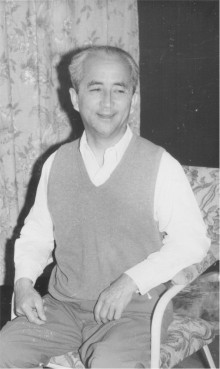
|
|
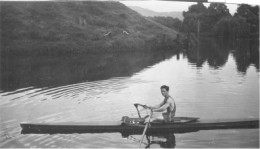
|
Photos
courtesy of Deian Ping. |
Note 2.
A 1925 news
article indicates inflatable cushions
were well known prior to the development of the surfoplane (The West Australian, 1925), while a 1922 letter to the editor advocated kapok
cushions as life saving
devices on yachts (The West Australian, 1922). Dr.Lee's
torpedo bouy from 1907, may also have been an influence
on Smithers (Vesper, 2006, contains
photos of Walter Biddell's torpedo bouy). Len
Smithers thought that the
yacht cushions
that were surfed were the initial design source rather than the
reported contribution of the broken surfboard. In an interview with
Ernest
Smithers he states, "I
discoverd these proportions through an accident I had with a copy in
rubber of an actual surfboard. It snapped in half in the surf, and I
found I raced ashore on one half, riding the breakers FASTER AND
STRAIGHTER than I could on a board." Continuing, he stated, "Those
seconds of practical
experiences taught me more than years and years of research. And the
result is what we have to-day - a faultless safety surfoplane." (Williams, 1934) At time
this article the dimensions of a surfoplane were 35 inches long x 27
inches wide.
- Lifebuoys For Yachtsmen.
(1922, March 21). The West Australian (Perth, WA : 1879-1954),
p. 9. Retrieved March 31, 2011, from
http://nla.gov.au/nla.news-article28163949.
- Pneumatic Upholstery.
(1925, December 3). The West Australian (Perth, WA :
1879-1954), p. 4. Retrieved March 31, 2011, from
http://nla.gov.au/nla.news-article31895143.
- Vesper, Stan. 2006. Bronte:
the birthplace of surf life saving. Caringbah, N.S.W.: Playright
Publishing.
- Williams, J. (1934, January 6). Riding on Air in the Surf. The
Telegraph. Sydney, Australia.
Note 3.
Black
Sunday was February 6, 1938. The events have been documented, including
the role of Dr. Aubrey Ping in resucitating swimmers. Ping was elected to a posiiton of honorary medical
officer in
recognition of his role. Brawley reports he held this role for 25
years. See: Brawley, Sean.
(2007). The Bondi lifesaver: a history of an Australian icon.
Sydney: ABC Books for the Australian Broadcasting Corp.
Note 4.
For information on
Stan and Basil McDonald, see: Waverley Cemetery - Walk No. 2.
Waverly Council: Bondi Junction, NSW, Australia. Retrieved from http://www1.waverley.nsw.gov.au/library/localstudies/walks/cm_wk_2.asp,
as derived from these sources: Waverley Library's Local History
Collection; The Australian Encyclopedia; Australian Dictionary of
Biography. Last updated June 1, 2008. Excerpt follows:
16a. STAN McDONALD
(1882-1959) surf lifesaver
and beach inspector. Appointed the first Chief Beach Inspector of
Waverley Municipal Council. A member of the Bondi S.L.S.C. Awarded the
Silver Medal and Certificate of the Royal Shipwreck Relief and Humane
Society, and the Certificate of Merit of the S.L.S. Association, for
surf rescues. Nicknamed the "King of Bondi."
16b. BASIL (BAZ) McDONALD
(1913-1986) surf
lifesaver and beach inspector. Known as "Mr Bondi," he followed in his
father's footsteps as a Bondi lifesaver and beach inspector, and the
family business of hiring out beach equipment at Bondi Beach. Awarded
the Order of Australia in 1980, he took part in many rescues, including
"Black Sunday" in 1938.
Note 5.
Photograph's
caption reads (Cadigan, 2008), "Clovelly's
Max Lambert is first away in the surfoplane race at a Manly carnival in
the 1930s." Another book (Brawley, 2007, p.
194) recounts Brian Hutchings
breaking a draw in a 1953 competition
with South Africa, "Hutchings was well versed in the ways to maximise
the performance of the rubber mats. The South Africans competed with
their surfoplanes pumped to capcity, reducing their speed and
manoeuvrability. Hutchings released some air from his so that he and
the surfoplane became one."
- Cadigan, N. (2008). Evolution
of an icon: 100 years of surf
life saving in NSW.
Sydney: University of New South Wales Press, pp. 130-131.
- Brawley, Sean. (2007). The
Bondi lifesaver: a history of an Australian icon. Sydney: ABC Books
for the Australian Broadcasting Corp.Galton, B. (1984).
- Gladiators
of the surf: The Australian Surf Life Saving Championships, a history.
Frenchs Forest, N.S.W: Reed. For more on Holcombe, see Surfresearch: 1933
Surf-o-plane 2 ft 7"#146
Note 6. In
addiiton to his historic flight from California to Brisbane, in 1928,
Brawley (2007) notes that Charlie Smith and his cousin nearly drowned
at Bondi on February 1, 1907. Smith was found unconscious and required
resuscitation. Also see: "Air Commodore Sir Charles Kingsford Smith,
MC, AFC (1897–1935)" in Fifty Australians. Australian War
Memorial. Retrieved from http://www.awm.gov.au/.
In 1934, the The
Sydney
Morning Herald announced
that Surfoplanes
Ltd was registered in Sydney, with a capital of 20,000 pounds. An
agreement was reported between Ernest Smithers and Sir Kingsford Smith,
and T.H. Wynne-Lewis to carry on as vendors, hirers and manufacturers
of Surfoplanes. Kingsford-Smith and Smithers were cited as first
directors. See: Company
News. (1934, April 11). The Sydney
Morning Herald (NSW : 1842-1954), p. 15. Retrieved March 31, 2011,
from
http://nla.gov.au/nla.news-article17072364.
Note 7.
Three documents are known to exist in relation to the patent/design
process of surfoplanes:
- Application for
registration of a design by
Ernest Eric Smithers and Carl Dodson Richardson for A surf plane -
Class 3. 9929. Dated 7.10.1932. M. Carson on behalf of Beach Chairs
Limited of Coogee wrote to the patent office on 31 March 1933, asserting
that surfboards "inflated by air have been sold in the shops of Sydney
for several years" and on 27 April 1933, that the company has
"suspended manufacture of surf floats" pending the patent application
process.
- Application for
Letters Patent for an invention by
Surfoplanes Limited titled - Improvements in or relating to pneumatic
surf boards or floats. Subsequent to Smithers application to obtain a
patent on the surfoplane (21.02.1933) on 6-7 February 1935, a hearing
was held by the Deputy Commissioner of Patents, to hear the objection
filed by Hardie Rubber Company to Smithers and Richardson's patent
application (11456/1933).
- Smithers Ernest E, et al. (1936, December 15; filed February 19, 1934). Pneumatic surfboard or float. U.S.Patent No. 2,064,128. Washington, D.C.: U.S. Patent and Trademark Office. Retrieved from http://www.freepatentsonline.com/2064128.html. [See PDF file.]
At the February 6-7, 1935, hearing it
was alleged that between December 1931 and "early" 1932, Smithers had
approached a number of companies (Hardie, Dunlop, Ago Supply and Pope
Alliance) to manufacture the surfoplane. Negotiations with Hardie
Rubber recommenced around July 1932, and in November 1932, four to five
floats were manufactured. It would seem that at some stage Hardie
Rubber developed their own version of the surfoplane. The hearing
involved significant legal argument around whether the design had been
publicised, was novel (Jordan's swimming floats, work on a similar
device by Stevens, and U.S. rubber surfboards were cited), as well as the
issue of whether Hardie was bound by confidentiality provisions and
what "substantially rectangular" and "parallel" meant. Smithers's
knowledge and exposure to these other floats is unknown.
Teece, the Deputy
Commissioner of Patents, reserved his judgment. However,
subsequent renewal fees paid by Surfoplanes Limited, through 21.03.1944,
indicate a patent was granted. Persons involved with the company
included Carl Dodsworth Richardson and Frank Knight who were associated
with promotional marketing.
Note
8. See: Bowes, Pete.
(2010, November 24). Surfoplanes ~ their place in the scheme of things.
petebowes.com. Retrieved from http://petebowes.com/.
Pete Bowes tells his story of riding a surfoplane at Bondi.
Note 9.
See also the brief piece containing a photo of a "surf girl" at Bondi
with her "Dunlop Perdriau rubber surfboard" (Cairnes Post, 1932). The Farmer's Rubber advertisement (The Sydney Morning Herald, 1932) for
rubber surfboards indicated dimensions of 54 inches long and 17 inches wide.
Dunlop Perdriau
rubber surfboard. February 1932; October 1932 SMH advertisement for a
rubber surfboard.
|
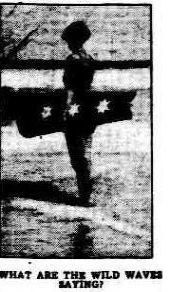
Source: Cairnes Post.
|
|
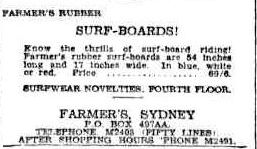
Source: The Sydney Morning Herald.
- What are the wild waves saying?. (1932, February 19). Cairns Post (Qld. : 1909-1954), p. 9. Retrieved March 31, 2011, from http://nla.gov.au/nla.news-article41141176
- Advertising. (1932, October 24). The Sydney Morning Herald (NSW : 1842-1954), p. 1. Retrieved March 31, 2011, from http://nla.gov.au/nla.news-article16924683
|
|
Additionally, note the
A1337 4420 Application for registration of a design by The Surf Rider
Company (assignee of John P McCarty and Fritz W Falck) for a pneumatic
float for surfing purposes - Class 14. Date 1923. This design did not
progress to the patent stage due to a the applicants not responding to
the examiner's report so it is unclear whether the Surf Rider Company
went into production.
The testing process for the
surfoplane is
unclear. At the patent hearing, Smithers's counsel, Thomas, sought to
establish that the surfoplane had not been
viewed in public, a key element in establishing Hardie Rubbers
development of a similar surfcraft and whether the design was already
in the public
domain. The process of testing surfoplane prototypes is not clear. Len
Smithers was six years old in 1932, and could only recall rubber,
surfoplanes and French chalk throughout the family home. The 1935
patent hearing makes no reference to the contribution of Aubrey Ping.
However the contribution of Vera Elizabeth Smithers, his
wife, was discussed. In the 1934, The Telegraph article, Smithers
noted his house was littered with rubber bags and "We stumbled over and
walked and slept on them for years. We talked about nothing else at
meal times. We lived on air!" This supports the involvement of Vera
Smithers in the development if the surfoplane. [See: Williams, J. (1934, January 6). Riding on Air in the Surf. The
Telegraph. Sydney, Australia.]
Len Smithers recalls another
type of surf
float being around at the time (Len Smithers,
personal communication, March 1, 2011):
"At the time there was a similar thing,
but it was very thin, long and was very soft. You couldn't properly
float on it, you could, it wasn't like a surfoplane. The difference
was, if you wanted to go out in a big surf and a huge wave came at you,
you could put your back to it and put a bear hug on it and you could
survive. The other type, you could fold it up. There was a certain
amount of rigidity in a surfoplane that would stand a big wave, to come
down big waves."
Len emphasised the
proportions of a surfoplane - length, width and height. These other
surfcraft were reported as being "about 5 feet in length, about roughly the
same width, it was very thin though only about 2" thick and with 8-9
little panels across. It was terribly soft. There were a few of them
around but they didn't take off" (Len Smithers,
personal communication, March 5, 2011).
The board
featured in Popular Mechanics (1924), and in earlier patents,
such as the Surf Coaster (Gulbrandsen, 1916) or the Inflatable Vulcanized Article (Hopkinson, 1928) indicate that others had previously worked on the
idea of an inflatable surfcraft.
- Unknown. (1924, September).
Pneumatic Boards for Surf Riders Are Safe and Easily Carried. Popular Mechanics, 42(3), 362. Retrieved from Google
books.
- Gulbrandsen, Michael A. (1916, November 28). Surf Coaster. U.S.Patent No. 1,206,696. Washington, D.C.: U.S. Patent and Trademark Office. Retrieved from http://www.freepatentsonline.com/1206696.pdf.
- Hopkinson, Russell. (1928, May 29). Inflatable vulcanized article. U.S.Patent No. 1,671,642. Washington, D.C.: U.S. Patent and Trademark Office.Retrieved from http://www.freepatentsonline.com/1671642.html.
Smithers's U.S. patent acknowledges
the existence of earlier pneumatic surf craft. His patent, however,
reveals some of the experimental depth of the surfoplane and how it
differed from other craft. For example, Smithers recorded that speed
was enhanced by lengthening the partitions within the surfoplane,
making all compartments of approximately equal size, or increasing the
number of compartments. Stability was enhanced by a shorter partition
(e.g, 6 inches from end), having each outside compartment larger than the two
inside compartments, or by making the surfoplane stiffer. Length and width
were designed to enable paddling.
Even long before the modern inflatable rubber surf riders discussed
above were invented people from the Middle East crossed rivers
using inflatable
animal skins. The Assyrian
empire was
a dominant force from 1365–609 BC.
This relief of a siege depicts Assyrians crossing a moat or river using inflated
animal skins as flotation devices.
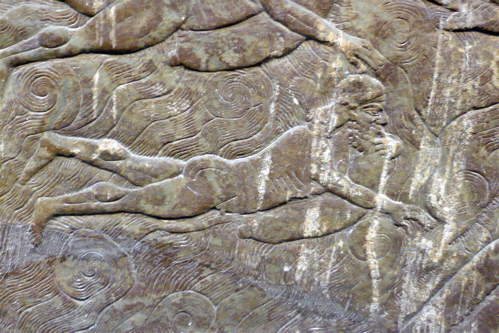
Source:
Claudia. (2010, November 19). Pinorama, Assyrian bliss, etc. [Web log
post]. Retrieved March 30, 2011, from
http://claudia.weblog.com.pt/arquivo/books/(maybe a relief on display
at The British Museum); and http://www.cosmeo.com/ (see above citation).
Note
10. SHOREthing, describes Movietone
Newsfilms that included footage of surfoplanes, including Movietone
News 9/14 (1938) which included photos of Smithers surfing a
surfoplane. Thoms reports (Thoms, 2000, p. 40) that this newsreel referred to the surfoplane
as bringing a "a new zest and a new technique to the sport of
surf-shooting." Interestingly the photo depicted of Smithers has
him kneeling on the surfoplane. Other newsreels
of surfoplanes in action were noted: 6/7 (1935), 7/15 (1936), 8/13
(1937), 10/6 (1939). Thoms reports that the latter newsreel featured
surfoplanes in 2-metre surf. Len Smithers reported "he went out in
these big seas and he got dumped by a big wave and burst his ear drum.
He was deaf for the rest of his life". (Lee Smithers, personal
correspondence, March 1, 2011).
- Thoms, Albie. (2000).
Surfmovies: the history of the surf film in Australia.
Noosa Heads, Qld: Shore Thing.
Thanks to Len Smithers,
June
Sturzaker,
Claire Harris and Alison Lee, the four children who contributed much of
the information regarding Dr. Ernest Smithers.
|
|